|
Detail of the Current Conveyor Technology
About NFB:
Simple and short signal transfer is best:
The NFB-10ES3 applies the newest ESS high-end Sabre32 DA chip
ES9018 which can support up to 32Bit/192KHz input .
ES9018
in voltage output model , there is -12DB THD+N worst , to be
achieve the best performance of ES9018 , must work in current
output model .
In some other ES9018 built in DAC design ,
ES9018 output signal have to through 3 step OPAs implement analogy
signal process .
The NFB-10ES3 had different design , applies Non-feedback ACSS
design. The ES9018 feed to the ACSS
circuit by balanced model without any OPAs .
The ACSS circuit naturally working in
current model and have design difference current input , it can
transfer the ES9018 current signal to output and implement the I/V
conversion in current model in one ACSS amp . And this ACSS amp only
have one current gain stage , the ES9018 output signal only through
one stage can arrive the output stages .
The shortest signal journey can reproduce the best
detail and dynamic, and almost without sound coloration , It can
show the real performance of the ES9018 .
So our ACSS design is the best combo with
ES9018 achieve the best performance .
Upside in the picture is the standard
ES9018 headphone amp design. The bottom is the NFB-10ES3 design .
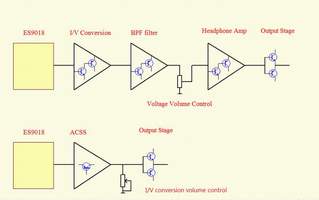
Super low THD ¡]Test by AP SYS-2722,0DBV output level)
Flat frequency response ¡]Test by AP SYS-2722)
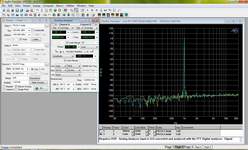
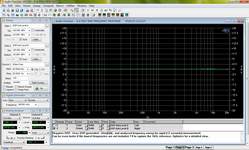
The ACSS also is a non-feedback
technology made with fully discrete amplifiers. Most people know the
global
feedback design can offer better specs in test measurements, and
non-feedback can't do well in test measurements but can offer better
sound for the human's ears. Here is a conflict of the classic circuits.
But the ACSS opens a new field, it can offer a least coloration sound
which is more neutral with very low distortion and high linearity. So
it can retain the dynamics, detail and neutral sound but not sound
bright or harsh.
The output buffers are
Non-feedback. For low impedance, we applied a diamond output stage
which is quite less colored than most conventional circuits.
The DAC is without couple
caps to avoid coloration. There are two OPAs built in as the DC serve to
keep the DC offset .
The 32bit / 384K USB interface
outputs a I2S signal to ES9018 . Cause by the limit of ES9018,
the NFB-10ES3 support up to 32bit 192KHz .
Multi-ply power supplies are the key of sound :
NFB-10ES3 applies the excellent DA chip ES9018 and excellent analog
output stages, but these are not the only keys of the best sound.
The power supply is most important. Even applying the best DA chip
and the best amp, if matched to a average power supply, the total
sound may still be average or sound musical but can't be neutral and
detailed. That is why it is easy to find hi-end grade gears maybe
without the best chips , but with plenteous dedicated
DC supply circuits.
The
NFB-10ES3
uses A total of 6 groups PSU power supply for all
digital and analog circuits.
To achieve high S/N, the
control circuit is powered with separate regulator.
Strong power supply.
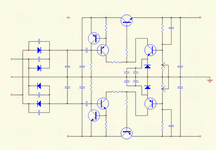
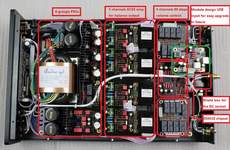
The I/V conversion
volume control without sound degradation:
Usually the volume control can be implemented in the DAC + amplifier
combo in two methods
Method 1: The
volume control is implemented into the digital stage. The major
drawback is that 1 bit of the D/A conversion is lost in every 6DB
volume reduction. So, even though the built-in DA chip is 32 bit, in
fact, only 16 bit may be left at low volume level.
Method 2: The
volume control is implemented in the analog amplifier input stage
through a volume pot to reduce the signal level. However, the volume
pot affects the sound quality adversely. A low grade volume pot
loses the details and creates channels imbalance resulting into
soundstage distortion. Even a high grade volume pot inevitably loses
the details. Both methods degrade the sound quality.
So, NFB-10ES3
applies the I/V conversion volume control, the volume control is
just a variable passive I/V conversion being placed at the ACSS
amplifier output, where the output is current signal but not voltage
signal. I/V conversion is to change the volume level from the
current (I) signal to the voltage (V) signal. (Like R-2R D/A chips
output passive I/V conversion) It can keep the signal frequency band
flat while not losing any detail. It does not degrade the sound
quality in every volume level. In front of the volume control, there
are four groups of diamond non-feedback buffer output stages that
offer very low output impedance.
Mark Levinson
also knows that current volume control has great benefits, so in the
volume control of his top grade hi-end preamplifier No.32, he uses
many components to change the voltage (V) signal to current signal
(I), then through the R-2R network to control the volume, and
finally changes back to voltage signal (V) again. NFB-10ES3 simply
works in current (I) signal domain, and technically, it is superior
to the conventional technology due to less conversion.
The volume
control quality is much more important in a real balanced gear. It
must guarantee the signals of the four channels are exactly the same
to bring out the benefits of a real balanced gear. If the cold
signal and hot signal of a balanced gear are not exactly the same,
the balanced output will has a large distortion causing the sound
quality and performance even much worse than a single end gear. This
is a waste of a balanced design and the additional cost.
NFB-10ES3
applies digitally controlled relay-based volume control in 160 steps.
It has 80 steps in both high gain and low gain mode to allow users
to control the volume level smoothly. NFB-10ES3 has two relay-based
volume control boards (totally four channels) through changing the
DALE resistors to control the volume to avoid channel imbalance,
achieving the best performance and sound quality of the gear.
Precise four-channel digitally controlled relay-based
volume control.
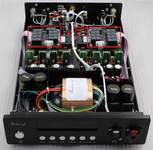
¡@ |

